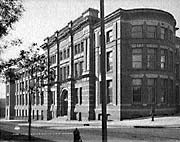Caspar Wistar
 |
| The Wistar Institute of Anatomy and Biology was founded by Isaac J. Wistar, the great-nephew of Caspar Wistar. The elder Wistar wrote the first American textbook on anatomy, A System of Anatomy, and spoke to Meriwether Lewis about fossils the explorer might find. Image courtesy of the Library of Congress, Prints and Photographs Division, Detroit Publishing Company Collection. |
Did brass buttons help the Lewis and Clark expedition? Well, in a manner of speaking.
Caspar Wistar got his start in colonial America as a maker of brass buttons,guaranteed to last seven years. He later opened the first successful glassmaking factory in the colonies. However, it was his grandson, also named Caspar, who earned a little more fame and helped the expedition. The young Wistar was a well-known Philadelphia doctor at the turn of the 19th century and chaired the anatomy department at the University of Pennsylvania. President Jefferson and he were members of the American Philosophical Society. In fact, he succeeded Jefferson as president of that organization in 1815. It was Jefferson who suggested that Meriwether Lewis visited with Wistar.
The purpose of the visit was not purely about the human anatomy, though Wistar had published the first American textbook on anatomy. No, Lewis was visiting because Wistar was the foremost authority on fossils in America. Jefferson himself shared an interest in that area. Wistar talked to Lewis about the Megalonyx, a prehistoric beast whose bones Wistar and Jefferson had discovered. Jefferson and Wistar believed that Lewis might find evidence of mammoths inhabiting the prairies in the West.
While Lewis' mammoth search didn't pan out, Wistar is still well remembered. His most famous innovation was the use of models of human anatomical features to help in his teaching. Many of the models he made were wood. Some were actually dried human limbs and organs that were injected with wax.
It seems the button maker's grandson turned out to be a craftsman in his own right.
< previous |



